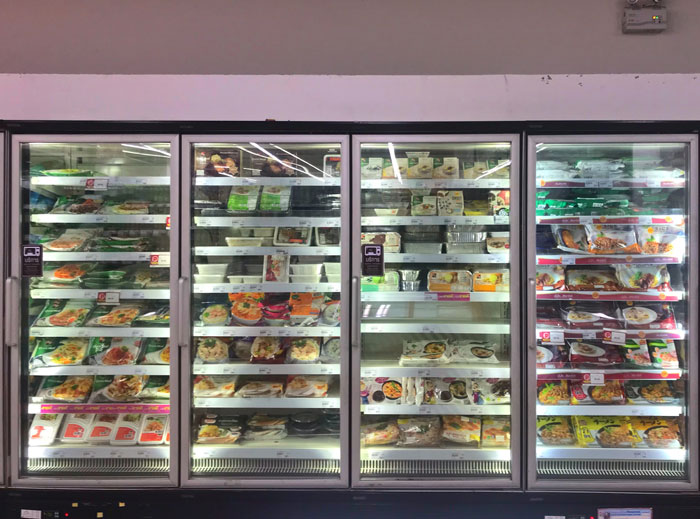Challenges to the control of Listeria monocytogenes in food products
- Like
- Digg
- Del
- Tumblr
- VKontakte
- Buffer
- Love This
- Odnoklassniki
- Meneame
- Blogger
- Amazon
- Yahoo Mail
- Gmail
- AOL
- Newsvine
- HackerNews
- Evernote
- MySpace
- Mail.ru
- Viadeo
- Line
- Comments
- Yummly
- SMS
- Viber
- Telegram
- Subscribe
- Skype
- Facebook Messenger
- Kakao
- LiveJournal
- Yammer
- Edgar
- Fintel
- Mix
- Instapaper
- Copy Link
Posted: 18 May 2021 | Masja Nierop Groot PhD | No comments yet
The rise of alternative proteins and novel side streams for more sustainable food production could introduce new ways for Listeria monocytogenes to spread. Masja Nierop Groot explores.


To assure our future food requirements and to protect the planet, developments are ongoing to make our food system more sustainable. Measures adopted to realise this include reduction of food loss and waste, and a transition to a more plant-based diet.
It has been estimated that about 25 percent of all foods produced globally are lost due to microbial growth.1 In the context of sustainability, product shelf life is an important aspect to consider, as a substantial amount of current food waste can be attributed to products that have exceeded their expiration date.
From a logistical point of view, supply and demand for products with a short shelf life, such as chilled, fresh products or ready-to-eat (RTE) foods, is particularly challenging. Food producing companies are faced with the challenge of maximising the shelf life of their products to meet the demand of retailers and consumers but without compromising its safety. This raises concerns when expiration dates are stretched to avoid food waste. Moreover, the consumer’s preference for clean label and aversion to E-numbers poses new challenges for food producers to minimise (future) food safety risks.
Food safety has not received the same level of attention as food loss and waste; however, the impact of food recalls due to microbiological hazards on food loss is high. Listeria monocytogenes is one of the pathogens of concern in chilled food products.
Listeriosis
Listeriosis is the disease caused by the bacterium L. monocytogenes, and is among the world’s most severe foodborne diseases. Although it has a relatively low incidence (in the EU 4.7 cases per million people in 2016),2 the impact on the disease burden is high due to the mortality rate of 20‑30 percent. The elderly are known to be more susceptible to infection with L. monocytogenes compared to the younger population, hence with the ageing population, prevention of listeriosis will be even more important in the future. Neonates, pregnant women and immunocompromised persons are also at higher risk of listeriosis.
The most severe listeriosis outbreak dates back to 2017-2018 in South Africa, involving more than 1,000 cases of which almost 200 patients died. Eventually, the contamination source was traced back to polony, which is a processed RTE meat product. Whole genome sequencing of isolates from patients, the environment and the product indicated that the outbreak was caused by polony produced at a single production facility.3
Foodborne outbreaks have been typically associated with RTE food products including dairy, fish, seafood and processed meat product categories,4 but also RTE salads and leafy greens. A survey among RTE meat and fish products in Europe for the period 2010-2012 revealed a prevalence of L. monocytogenes of 2.07 percent and 10.3 percent, respectively, in these food categories at the end of shelf life.4
New commodities
A severe L. monocytogenes outbreak occurred in 2018 in Europe involving frozen vegetables. Traceability information for the contaminated products indicated the source of contamination to be in a freezing plant by a persistent L. monocytogenes present in one of the freezing tunnels. Implicated frozen products were distributed to 116 countries and led to reported illness of 54 people in six countries, of which 10 died. This case shows that new commodities, which have not been previously considered a risk of listeriosis, are emerging. This concern was also raised in a recent expert opinion report from the European Food Safety Authority.5 Another example is the L. monocytogenes outbreak in 2015 caused by Blue Bell ice cream in the US (causing illness in 10 people from four states, and three deaths). The outbreak led to a recall of all Blue Bell products and a shutdown of its production plants.


L. monocytogenes is one of the pathogens of concern in chilled food products
L. monocytogenes is ubiquitously present in the environment, entering a factory via an array of raw materials or plant-based products. L. monocytogenes is able to survive in biofilms in the food processing environment, which could lead to recurrent contamination. The prevalence of L. monocytogenes on plant or vegetable food products worldwide has been reported at levels of 0.9 to 25 percent.6
To date, there have been no recalls or outbreaks reported for plant-based protein products such as meat analogues; however, L. monocytogenes could be associated with chilled plant-based protein foods. Furthermore, the market for plant‑based meat and dairy replacers is growing rapidly, increasing the demand for effective strategies to control L. monocytogenes in response.
Legislation
In European Food legislation, a food safety criterion has been laid down for L. monocytogenes for RTE food products. Intrinsic food conditions that do not support L. monocytogenes growth have been established in EU regulation and include a pH < 4.4, Aw < 0.92, or a combination of pH < 5.0 and Aw < 0.94, or NaCl > 16 percent (Regulation (EC) No. 2073/2005). When products do not meet these parameters and/or rely on other inhibiting factors to control growth, they need to be validated for each specific RTE food product in a challenge study.
In the USA, the food safety standard for L. monocytogenes differs from that of the EU; according to US legislation, a zero tolerance is in place for RTE products placed on the market.
Control measures for Listeria monocytogenes
The use of adequate sanitation procedures is a prerequisite in risk prevention, but besides this, new and effective control measures for this food pathogen are required, as the use of new protein sources or side streams for more sustainable food production systems could introduce new vehicles for L. monocytogenes.
The implementation of natural antimicrobials is one approach to control L. monocytogenes in food products that meets the consumer preference for clean label solutions. New solutions could, for example, be provided by using food cultures, ferments or bacteriophages. Organic acids and ferments already have a long history of use and proven efficacy for many food products, including processed meat products.
New protein sources or side streams for more sustainable food production systems could introduce new vehicles for L. monocytogenes
It remains important to assess the effectiveness of these solutions for new food matrices that appear on the market, driven by the protein transition movement. This may require adjustment of currently developed solutions to optimise performance in plant-based counterparts.
Traditionally, food cultures have been used to improve the shelf life and safety of foods, and their use has increased enormously over the last decade – receiving increasing attention as clean label solutions to preserve food products. Bacteriophages have proven to be capable of eliminating low-level contaminations with pathogenic bacteria including L. monocytogenes and therefore is a feasible option for a biocontrol agent for food.
Predictive models are increasingly being used in food safety control as they can reduce expensive experiments. For wider implementation and accuracy of these models, more antimicrobials must be quantified and implemented. One area for innovation is the development of models that have the flexibility to include new (combinations of) antimicrobials and/or a broad product range. However, more parameters must be quantified and implemented in relevant product matrices for this to be feasible, including plant-based meat and dairy analogues.
Wrap-up
Food safety is of eminent importance for the protection of consumers and brand reputation. Besides the societal impact of listeriosis on public health, the financial impact for companies can be huge in terms of lawsuits, recalls, loss in sales and consumer trust.
The use of new protein sources and side streams to create sustainable food production systems could also introduce new commodities for food pathogens. For chilled RTE food products, L. monocytogenes is a pathogen of concern that limits shelf life. Effective, validated solutions are desired as interventions for plant-based meat and dairy alternatives that meet the consumer’s preference for clean solutions to enhance shelf life, but also assure product safety.
Potential ingredients such as bacteriophages, use of food cultures and fermentation can provide new (natural) solutions to control growth of L. monocytogenes in plant-based products. New mathematical models to describe and predict microbial growth are required.
Wageningen Food & Biobased Research intends to set-up a consortium project focusing on innovative solutions for enhanced control of L. monocytogenes in plant‑based meat and dairy alternatives and developing predictive mathematical models. The MINIScreen (Matrix INteractIon Screening) platform will be used for fast screening in miniaturised food.
For more information click here.
Masja Nierop Groot, PhD
Masja is Senior Scientist at Wageningen Food & Biobased Research. Her activities focus on the control of food pathogens and spoilage organisms to safeguard the safety and quality of food and ensure shelf life.
References
1. Bondi MP, et al. (2014). “Emerging microbial concerns in food safety and new control measures.” BioMed Research International 2014: 251512-251512.
2. EFSA (2017). The European Union summary report on trends and sources of zoonoses, zoonotic agents and food‐borne outbreaks in 2016. EFSA Journal 2017;15(12):5077, 228 pp. https://doi.org/10.2903/j.efsa.2017.5077
3. Thomas JN, et al. (2020). “Outbreak of Listeriosis in South Africa Associated with Processed Meat.” New England Journal of Medicine 382(7): 632-643.
4. EFSA (2018). “Listeria monocytogenes contamination of ready-to-eat foods and the risk for human health in the EU.” EFSA Journal 16(1): e05134.
5. EFSA (2020). “The public health risk posed by Listeria monocytogenes in frozen fruit and vegetables including herbs, blanched during processing.”
EFSA Journal 18(4): e06092.
6. Zhu Q, Gooneratne R, Hussain MA. (2017).
Listeria monocytogenes in Fresh Produce: Outbreaks, Prevalence and Contamination Levels. Foods.
Mar 9;6(3):21. doi: 10.3390/foods6030021.
Issue
Related topics
Food Safety, Lab techniques, Plant based, Proteins & alternative proteins
Related organisations
Blue Bell Ice Cream, European Food Safety Authority (EFSA), Wageningen Food & Biobased Research









